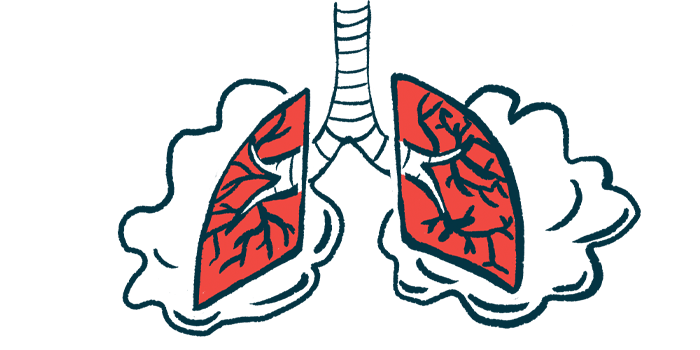Researchers define threshold for breathing improvement with ERT
Study applies data from trial to measure LOPD patients' perceived gains

Researchers defined a threshold for improvements in lung function that adults with late-onset Pompe disease (LOPD) perceive as clinically meaningful when treated with enzyme replacement therapies.
A study found that when thresholds were applied to data from the Phase 3 COMET study, more Pompe patients treated with the ERT Nexviazyme (avalglucosidase alfa) experienced meaningful improvements in lung function than those who received Lumizyme (alglucosidase alfa).
“It remains important to quantify whether the improvements in respiratory function observed in clinical trials are associated with patient perception of a clinical benefit,” the researchers wrote.
The study, “Defining clinically meaningful thresholds for forced vital capacity in patients with neuromuscular disorders: Lessons learned from the COMET study in Pompe disease,” was published in the Journal of Neuromuscular Diseases.
Pompe disease is caused by a deficiency in the enzyme acid alpha-glucosidase (GAA), leading to the toxic buildup of glycogen, a complex sugar molecule, particularly in muscle cells. The resulting cellular damage gives rise to progressive muscle weakness and poor muscle tone that can affect motor function and breathing.
Breathing improvement is a goal of ERT
Depending on the levels of residual GAA activity, the disease can manifest in the first year of life, in which case it’s called infantile-onset Pompe, or after the first year, when it’s referred to as LOPD.
ERT, a standard treatment for Pompe disease, involves using a lab-made version of GAA to replace the missing or nonworking enzyme.
The effectiveness of ERTs is based partly on their impact on breathing, which is often measured by forced vital capacity (FVC), the volume of air that can be forcefully exhaled after a deep breath. The amount of FVC change needed for patients to perceive a noticeable benefit, or the clinically meaningful threshold (CMT), has yet to be defined for Pompe.
“One important goal common for clinical trials is determining if the effect of the experimental treatment is significantly better than that of the control treatment,” the researchers wrote. “However, statistical significance does not, by itself, indicate whether the detected effect corresponds to a clinically meaningful treatment effect for patients.”
To define the CMT for FVC in Pompe, researchers leveraged data from the Phase 3 COMET trial (NCT02782741). COMET compared the impact of Nexviazyme versus Lumizyme on upright FVC in LOPD patients who had never received an ERT. Sanofi, which markets both ERTs, sponsored the CMT analysis.
COMET enrolled 99 adults with LOPD (52% men), randomly assigned to receive Nexviazyme or Lumizyme for 49 weeks, or about one year. Participants who completed COMET could enroll in an open-label extension (OLE) study, in which all were treated with Nexviazyme for 240 weeks (more than 4.5 years).
COMET’s top-line results showed that Nexviazyme generally outperformed Lumizyme in improving FVC, but the difference was not statistically significant. Interim data from the OLE suggested that Nexviazyme benefits seen in COMET were maintained for up to two years.
In addition to FVC, participants completed several patient-reported outcome measures to assess the perceived impact of ERT on breathing. Based on data at weeks 49 and 97, CMTs were calculated as either within person, the threshold for a patient to perceive a clinical benefit, or between group, the threshold to evaluate differences between groups of patients receiving differing therapies.
According to the analysis, the within-person CMT for the absolute change in FVC was 3% at week 49 and 2.9% at week 97, meaning patients perceived these FVC improvements as a meaningful benefit. The between-group CMT for the absolute change in FVC was 2.1% at week 49 and 1.2% at week 97.
The researchers then applied the within-person CMTs to determine the proportion of patients who achieved a meaningful FVC improvement with Nexviazyme versus Lumizyme at week 49.
At the 3% CMT, more patients in the Nexviazyme group showed an improvement in FVC from the start of COMET to week 49 compared with those in the Lumizyme group. Further analysis confirmed that fewer patients treated with Nexviazyme experienced a worsening of FVC than those treated with Lumizyme.
Finally, the between-group difference in FVC between the Nexviazyme and Lumizyme groups in COMET of 2.43% at week 49, which was above the estimate of 2.1%, “suggesting a clinically meaningful difference for the patient between the two treatments,” the team wrote.
“This analysis successfully identified a narrow range of within-person and between-group CMTs for upright FVC (% predicted) in LOPD,” the researchers wrote. “This study’s findings may aid in interpretation of data obtained from interventional studies in other neuromuscular conditions.”







